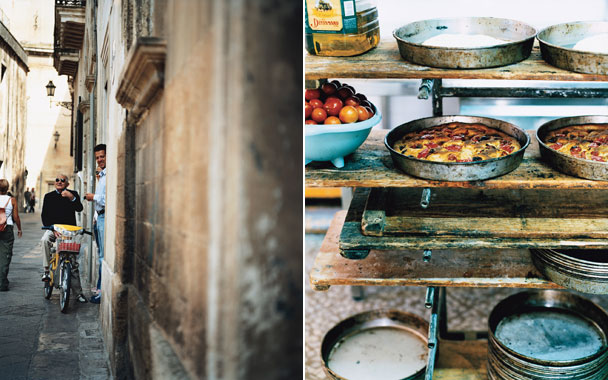Two winds blow across the region of Puglia, in Italy’s heel. One is the mistral, which blasts across the Adriatic laden with the cold of the Balkans, and the other is the sirocco, the breath of the south. The sirocco wafts fierce heat from North Africa and moisture from the Ionian sea, and the first time I came to Lecce, about eight years ago, all the car windshields were covered in Saharan sand. I found that people in this city often frame their conversation in terms of the two winds, for the Adriatic lies just to the east and the Ionian to the south and west. Each of the region’s coasts has its own wind, its distinct terrain and marine life, and its own dialect. But Puglia (a designation that in our language has succeeded the sweeter, Latin Apulia) is joined by the fact that it has often been poor and lorded over by foreigners; no aspect of the civilization of the Renaissance was invented here. That’s not to say that the Puglians don’t have a style of their own, however: When they get hold of an interesting idea, they often reduce it to its simplest, purest form, in everything from architecture to the food on their tables.
Nearing the walls of Lecce, one of Europe’s most beautiful cities, I caught sight of the pinnacles of fantastic towers, colorfully tiled domes, and the crowns of palms. Then a whitish labyrinth swallowed me up: The pale leccese stone, whose texture people compare to the fluffy mollica (inside) of the local bread, is so soft that it can be rapidly carved into the shape of any ornament, which explains the overloaded facades of the town’s principal buildings. These rows of palazzi are almost all in the Baroque style, but their arches are corroded and their volutes half-effaced—walking among them, I felt at times as though I were wandering a city of sand castles.
Many of Lecce’s monuments were built in the late 17th century by renowned architect Giuseppe Zimbalo or one of his colleagues. Though the Baroque may be the least lovable of all European architectural styles, Zimbalo knew how to simplify it. The town’s narrow streets, enlivened by churches crawling with fabulous beasts, lead to the entrance to the main square, the Piazza Duomo—it’s the architectural equivalent of a strait, and I happened on it by chance. Through the narrow gap between two buildings, watched over by a row of stone saints, I found myself staring at a perfectly proportioned 17th-century stage set, complete with campanile, cathedral, episcopal palace, and seminary. True, it is a show of Baroque style, but compared with the ornate buildings of Rome or central Europe, it is pared-down indeed.
I discovered that as it goes in architecture, so it goes with Puglian cooking, which is noted for its simple, delicious vegetable dishes. On that first trip to Lecce, I sought out a restaurant that had been recommended to me. I walked beneath a neon sign reading “Trattoria Cucina Casereccia” and into a brightly lit chamber. It was nine-thirty in the evening, and there was no food in sight. The décor suggested a pensioners’ club, but in the middle of the room, in high heels and gold jewelry, stood an attractive woman in late middle age. She was illumined by a single lighting fixture that hung, tiara-like, over her regal coiffure. She looked more like a beautician than a cook.
“Is this really a restaurant?” I asked.
“Sit down,” she said, in Italian. It was not an invitation, it was an order.
“I am Concetta Cantoro,” the woman said. “If you’re hungry, put yourself in my hands. I can’t stand bad appetites or fussing over food. You’ll eat what I give you, understood?”
I had just taken a seat when, to my relief, a party of two couples came in, eliciting cries of joy from the proprietress. The particular object of her enthusiasm was a gentleman of a certain age, sprightly and bewhiskered, who looked like a music-hall comedian. “Ah, little Federico!” Concetta said, embracing him and pinching his cheeks.
Federico and his wife and the other couple sat down at a nearby table. “I am Concetta’s cousin,” Federico announced to me.
Meanwhile roasted peppers and pickled eggplant arrived at my table, delivered by a stocky, gray-haired man who introduced himself as Marcello, Concetta’s husband. Wine was set down, and then ’ncapriata, the local specialty, a delicate purée of fava beans dressed in olive oil and escorted by mustard greens. Concetta told us about fava beans, about what a fava bean really is—its ineffable essence, you might say. She told us about the taieddha—a scrumptious dish of thinly sliced potatoes and zucchini, baked with mussels and the liquor of the mussels—that Marcello was just then putting on my table. Talking and talking, Concetta spun from one table to the other like a figure on a music box.
Federico addressed me in a stage whisper. “This isn’t a restaurant really, it’s a café chantant.”
Marcello, bringing in dish after dish, would each time kneel beside me, catch my eye briefly, look worshipfully up at his wife, then screw the knuckle of his right index finger into his cheek—the sign for good eating. More food arrived—vegetables, cuttlefish, filets, braised meat—and all the while Concetta twirled, speaking of America and tomatoes.
When at last I rose to leave, I glanced up at the clock: two-thirty in the morning. I had been gorging myself for five hours. As I lurched out the door, Concetta wished me sweet dreams.



 Pinterest
Pinterest






